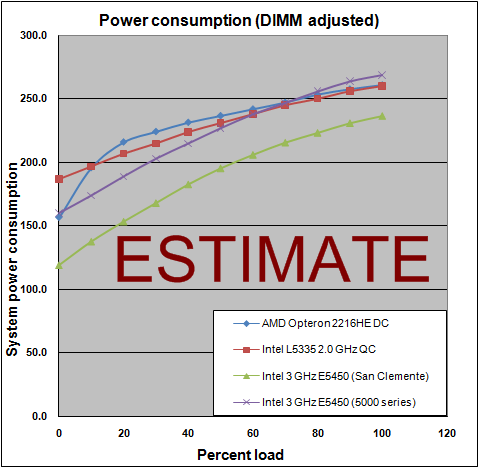San Clemente chipset gives HP lead on energy efficiency

The January 30th 2008 batch of test results are in for SPECpower_ssj2008 energy efficiency benchmark and it looks like Hewlett Packard has claimed the energy efficiency lead with their newest low-cost 2U HP Proliant DL180 G5 server. The secret to their success appears to lie in the selection of the Intel 5100 series "San Clemente" chipset. While the detailed SPECpower disclosure doesn't actually mention the chipset anywhere, the power characteristics, the six memory DIMMs, and the ICH-9 storage is a dead giveaway.
To see where the modern servers stand on power consumption, I've plotted out some ESTIMATED charts to compare the results. Since the AMD system from Colfax International has 8 registered DDR2-667 DIMMs and the HP San Clemente system has 6 registered DDR2-667 DIMMs, I've had to adjust them both down to 4 DIMMs to do a fair comparison with the other Intel systems which used 4 DIMMs. To do this I had to use an approximation based on known measurements for memory power consumption and I subtracted 1.875 watts to 3.75 watts for each registered DDR2-667 DIMM on a linear sliding scale based on load percentage. That means I subtracted 7.5 watts for the AMD system at idle and 15 watts for the AMD system at peak power. For the HP San Clemente system I subtracted 3.75 watts at idle and 7.5 watts at peak loads.

Since it was shocking that a dual-processor eight-core 3 GHz Intel system was drawing lower power than a dual-processor four-core 2.4 GHz AMD system, I thought something might be a little off. I realized that Colfax had used a pair of redundant 700 watt power supplies whereas the HP San Clemente system uses a single 750 watt power supply which means the power supply for the AMD system is relatively inefficient. At this point I had to make a reasonable guess at PSU (Power Supply Unit) efficiency and I guessed that the HP single power supply had to be around 80% efficient whereas the Colfax dual-PSU would be around 70%. Therefore I estimated the power consumption of the AMD system had it used an 80% efficiency power supply instead of a 70% efficient power supply.
Unfortunately this is a rough educated guess so the accuracy is dropping quickly but I wanted to take a reasonable shot at it to level the playing field on PSU efficiency. Companies in the future when making SPECpower submissions should avoid using dual power supplies and stick with 4-DIMM configurations so that we can get apple to apple comparisons and measurements. For now the following estimated power consumption graph is what I came up with.
The thing that really sticks out is the fact that the Intel 3 GHz 45nm E5450 processor system uses less power most of the time than the special low-voltage variant of the Intel 2 GHz 65nm L5335 processor. This shows how drastic an improvement Intel made using HKMG (High-K Metal Gate) materials and a shrink to the 45nm process.
The DIMM and PSU adjusted power consumption for the AMD Opteron 2216HE 4-core 2.4 GHz system has dropped significantly by more than 32 watts at the peak but it's still more power hungry than the Intel 8-core 3 GHz E5450 at less than 80% load. Despite the fact that AMD takes a deeper clock speed dive down to 1.0 GHz at idle while Intel only dives down to 2 GHz, Intel's C1E state seems to dominate the power savings.
This can also tell us something about the "Barcelona" quad-core "HE" (High Efficiency) 1.9 GHz system because it has a TDP of 79 watts which is 11 watts higher than the 2216HE under maximum load per CPU. Realistically the difference will be smaller than 11 watts per CPU and probably more like an 8 or 9 watts difference so an AMD 2347HE 1.9 GHz dual-processor 8-core version would probably consume 16 more watts. That would likely put the AMD 8-core 2347HE 1.9 GHz server at higher power consumption level than the 8-core 3 GHz E5450 Intel server running on a San Clemente chipset. That seems counter intuitive since Intel's TDP rating for its 45nm 3 GHz processor is 80 watt TDP and that doesn't even count the memory controller on the motherboard.
When looking at the difference between the HP San Clemente chipset based server and the HP 5000 series chipset based server, there is roughly a 32 to 40 watt difference even though the two CPUs are identical. Most of that difference is due to an extra 6 to 7 watts per FBDIMM and the remaining power delta is mostly due to the newer chipset on the motherboard. Had both of these servers had 8 DIMMs, the power gap would have been approximately 26 watts wider because of the extra power consumed by the FBDIMMs on the Intel 5000 series chipset.
Next I plot out the power-adjusted ESTIMATED energy efficiency numbers. I adjusted all the systems to four DIMMs and gave the AMD Opteron system a boost in power supply efficiency from an assumed 70% efficiency to 80% efficiency. Again this is a rough guess but it's reasonable considering the fact that Colfax used a dual 700W power supply instead of a single 750W power supply. If Colfax International is reading this blog then I would suggest to them not to shortchange their own results in the future and use 4 DIMMs and a single PSU like everyone else.
Hopefully the next batch of results will give us some performance numbers on faster single-socket systems using the Bigby chipset and a 45nm processor so we can see how high on the efficiency scale those servers will go.